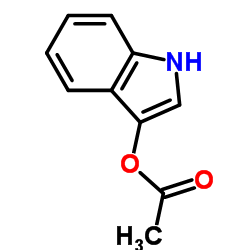3-Acetoxyindole

3-Acetoxyindole structure
|
Common Name | 3-Acetoxyindole | ||
|---|---|---|---|---|
| CAS Number | 608-08-2 | Molecular Weight | 175.184 | |
| Density | 1.3±0.1 g/cm3 | Boiling Point | 339.1±15.0 °C at 760 mmHg | |
| Molecular Formula | C10H9NO2 | Melting Point | 128-130 °C(lit.) | |
| MSDS | Chinese USA | Flash Point | 158.9±20.4 °C | |
| Symbol |

GHS07 |
Signal Word | Warning | |
|
Comparison of three rapid methods, tributyrine, 4-methylumbelliferyl butyrate, and indoxyl acetate, for rapid identification of Moraxella catarrhalis.
J. Clin. Microbiol. 32(5) , 1362-3, (1994) Moraxella catarrhalis can easily be differentiated from other oxidase-positive, gram-negative cocci with tributyrine, 4-methylumbelliferyl butyrate, or indoxyl acetate. All M. catarrhalis give positive reactions, and all Neisseria spp. give negative reactions... |
|
|
Arcobacter mytili sp. nov., an indoxyl acetate-hydrolysis-negative bacterium isolated from mussels.
Int. J. Syst. Evol. Microbiol. 59 , 1391-1396, (2009) Three Arcobacter isolates, recovered from mussels (genus Mytilus), and one isolate from brackish water in Catalonia (north-east Spain) showed a novel pattern using a recently described identification method for members of the genus Arcobacter, 16S rRNA gene R... |
|
|
Arcobacter molluscorum sp. nov., a new species isolated from shellfish.
Syst. Appl. Microbiol. 34 , 105-109, (2011) Nineteen bacteria isolates recovered from shellfish samples (mussels and oysters) showed a new and specific 16S rDNA-RFLP pattern with an Arcobacter identification method designed to recognize all species described up to 2008. These results suggested that the... |
|
|
Atypical Helicobacter canadensis strains associated with swine.
Appl. Environ. Microbiol. 72 , 4464-4471, (2006) Forty-two Helicobacter isolates were isolated from swine feces in The Netherlands and Denmark. All 12 isolates sequenced (16S rRNA gene) formed a robust clade with Helicobacter canadensis ( approximately 99% similarity). Species-specific PCR indicated that al... |
|
|
An important role for secreted esterase in disease establishment of the wheat powdery mildew fungus Blumeria graminis f. sp. tritici.
Can. J. Microbiol. 57 , 211-216, (2011) The activity of esterase secreted by conidia of wheat powdery mildew fungus, Blumeria graminis f. sp. tritici, was assayed using indoxyl acetate hydrolysis, which generates indigo blue crystals. Mature, ungerminated, and germinating conidia secrete esterase(s... |
|
|
Creating fast flow channels in paper fluidic devices to control timing of sequential reactions.
Lab Chip 12(23) , 5079-85, (2012) This paper reports the development of a method to control the flow rate of fluids within paper-based microfluidic analytical devices. We demonstrate that by simply sandwiching paper channels between two flexible films, it is possible to accelerate the flow of... |
|
|
Helicobacter canadensis sp. nov. isolated from humans with diarrhea as an example of an emerging pathogen.
J. Clin. Microbiol. 38(7) , 2546-9, (2000) We recently analyzed 11 helicobacter isolates cultured from diarrhea patients in Canada. These isolates had been characterized biochemically by restriction fragment length polymorphism (RFLP; AluI, HhaI) analysis and by fatty-acid analysis as Helicobacter pul... |
|
|
Hydrolysis of indoxyl acetate by Campylobacter species.
J. Clin. Microbiol. 25(8) , 1560-1, (1987) One hundred and twelve Campylobacter strains comprising 15 species and subspecies were examined for their ability to hydrolyze indoxyl acetate. All strains of C. coli, C. cryaerophila, C. fennelliae, and C. jejuni hydrolyzed the compound, whereas three strain... |
|
|
Evaluation of the indoxyl acetate hydrolysis test for the differentiation of Campylobacters.
J. Clin. Microbiol. 28(6) , 1482-3, (1990) Indoxyl acetate hydrolysis is a rapid, inexpensive differential test which can be performed easily to help identify campylobacter. A total of 571 Campylobacter cultures, including atypical variants, representing 10 species was tested. |
|
|
Chromogenic platform based on recombinant Drosophila melanogaster acetylcholinesterase for visible unidirectional assay of organophosphate and carbamate insecticide residues.
Anal. Chim. Acta 720 , 126-33, (2012) In this study we propose a chromogenic platform for rapid analysis of organophosphate (OP) and carbamate (CM) insecticide residues, based on recombinant Drosophila melanogaster acetylcholinesterase (R-DmAChE) as enzyme and indoxyl acetate as substrate. The vi... |